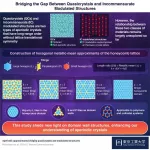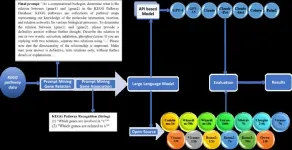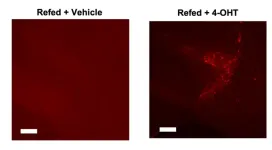(Press-News.org)
For a long time, scientists associated crystal structures with an ordered arrangement of atoms in a repeating lattice-like pattern, believing it to be the most stable configuration. However, by the 1960s, advancements in crystallography revealed materials that did not fit the traditional model. These structures exhibit a non-periodic or non-repeating pattern and are called aperiodic crystals.
There are two types of aperiodic crystals: quasicrystals (QCs), which exhibit ordered but aperiodic arrangements, and incommensurately (IC) modulated structures, where a three-dimensional periodic lattice structure is distorted by spatial variation or modulations. These materials possess properties distinct from those of usual periodic crystals, but the relationship between them remains largely unexplored.
In a study published in the journal Nature Communications, researchers led by Associate Professor Akihisa Koga from the Department of Physics at Tokyo Institute of Technology constructed a locally periodic honeycomb structure. They arranged small (S) and large (L) hexagonal as well as parallelogram (P) tiles in a two-dimensional space according to metallic means (generalizations of the well-known golden and silver ratios), introducing modulations to generate a honeycomb tiling pattern that represents an incommensurately modulated structure.
“We present hexagonal metallic-mean approximants of the honeycomb lattice, which bridge the gap between quasicrystals and incommensurately modulated structures,” says Koga.
Aperiodicity is closely tied to the distance between the atomic positions in the crystal lattice. In quasicrystals, these distances are defined as irrational numbers locked by two-length scales, while in IC modulated structures, they are not fixed. The researchers applied an aperiodic approximation to arrange the tilings within the crystal lattice. They varied the characteristic irrational in the lattice according to metallic means, such as the golden mean, silver mean, and bronze mean. Specifically, they arranged the tiles so that the ratio between the long length (representing the size of the large hexagon) and the short length (based on the side of the small hexagon and the parallelogram tile) corresponded to different metallic means.
Initially, arranging the tiles by taking the golden mean as the length ratio resulted in large hexagonal tiles bounded by parallelograms and smaller hexagonal tiles, creating an ordered but non-periodic quasicrystalline structure. However, as the metallic-mean ratio increased, the larger hexagonal tiles began to come together, forming honeycomb domains, considered as an IC modulated structure.
The researchers identified the metallic-mean tiling pattern in polymers using an ISP (I: polyisoprene, S: polystyrene, and P: poly(2-vinylpyridine)) triblock terpolymer. From the transmission electron microscope images of the polymer, they observed that the polymer arrangements could be represented by L, P, and S tiles with a regular region of L tiles at the center, and P tiles to its left. The P tiles were interpreted as twin boundaries marking the transitions between different orientations of the L tiles.
This tiling pattern was also observed in colloidal particles. The researchers simulated the behavior of 10,000 colloidal particles interacting with a Lennard-Jones-Gauss potential, finding that the ideal arrangement for the particles is a metallic-mean tiling, consisting of up and down triangles.
“Our study highlights the effectiveness of aperiodic approximants in inducing modulations within self-assembled soft-matter systems employing the P31m plane group. Specifically, we utilized the rows of P tiles as domain boundaries in the honeycomb lattice, thereby bridging metallic-mean hexagonal QCs and IC modulated honeycomb lattices,” says Koga. “These findings provide insights into the realm of both aperiodic crystals and their broader implications for domain wall structures across various fields.”
###
About Tokyo Institute of Technology
Tokyo Tech stands at the forefront of research and higher education as the leading university for science and technology in Japan. Tokyo Tech researchers excel in fields ranging from materials science to biology, computer science, and physics. Founded in 1881, Tokyo Tech hosts over 10,000 undergraduate and graduate students per year, who develop into scientific leaders and some of the most sought-after engineers in industry. Embodying the Japanese philosophy of “monotsukuri,” meaning “technical ingenuity and innovation,” the Tokyo Tech community strives to contribute to society through high-impact research.
https://www.titech.ac.jp/english/
Institute of Science Tokyo (Science Tokyo) will be established on October 1, 2024, following the merger between Tokyo Medical and Dental University (TMDU) and Tokyo Institute of Technology (Tokyo Tech), with the mission of “Advancing science and human wellbeing to create value for and with society.”
https://www.isct.ac.jp/en
END
The possibility of hydrogen-powered flight means greater opportunities for fossil-free travel, and the technological advances to make this happen are moving fast. New studies from Chalmers University of Technology, in Sweden, show that almost all air travel within a 750-mile radius (1200 km) could be made with hydrogen-powered aircraft by 2045, and with a novel heat exchanger currently in development, this range could be even further.
“If everything falls into place, the commercialisation of hydrogen flight can go really fast now. As early as 2028, the first commercial hydrogen flights in Sweden could be in the air," says Tomas Grönstedt, Professor at Chalmers ...
Some people lose weight slower than others after workouts, and a Kobe University research team found a reason. They studied what happens to mice that cannot produce signal molecules that respond specifically to short-term exercise and regulate the body’s energy metabolism. These mice consume less oxygen during workouts, burn less fat and are thus also more susceptible to gaining weight. Since the team found this connection also in humans, the newly gained knowledge of this mechanism might provide a pathway for treating obesity.
It is well known that exercise leads to the ...
In Rhode Island, USA, over one in four emergency department (ED) patients at high risk of overdose has a non-fatal opioid overdose in the 18 months post-discharge. A parallel, two-arm, randomized controlled trial conducted in Rhode Island of over 600 ED patients at high risk of opioid overdose found that support from a peer recovery support specialist (a trained support worker with lived experience of addiction) was as effective in reducing opioid overdose as support from a licensed clinical social worker. In other words, interviewing and intervention techniques informed by lived ...
Washington, July 11, 2024—Predictive algorithms commonly used by colleges and universities to determine whether students will be successful may be racially biased against Black and Hispanic students, according to new research published today in AERA Open, a peer-reviewed journal of the American Educational Research Association. The study—conducted by Denisa Gándara (University of Texas at Austin), Hadis Anahideh (University of Illinois Chicago), Matthew Ison (Northern Illinois University), and Lorenzo Picchiarini (University of Illinois Chicago)—found ...
Understanding complex biological pathways, such as gene-gene interactions and gene regulatory networks, is crucial for exploring disease mechanisms and advancing drug development. However, manual literature curation of these pathways cannot keep pace with the exponential growth of discoveries. Large-scale language models (LLMs) trained on extensive text corpora contain rich biological information and can be leveraged as a biological knowledge graph for pathway curation.
Recently, Quantitative Biology published a study titled "A Comprehensive ...
LA JOLLA, CA—Do you grab a fork and take a first bite of cake, or say no and walk away? Our motivation to eat is driven by a complex web of cells in the brain that use signals from within the body, as well as sensory information about the food in front of us, to determine our behaviors. Now, Scripps Research scientists have identified a group of neurons in a small and understudied region of the brain—the parasubthalamic nucleus (PSTN)—that controls when an animal decides to take a first bite of food.
In the study, published in Molecular Psychiatry on July 4, 2024, the team of scientists set out to selectively manipulate a group of PSTN cells that dial up their ...
RIVERSIDE, Calif. -- Quantum computing, which uses the laws of quantum mechanics, can solve pressing problems in a broad range of fields, from medicine to machine learning, that are too complex for classical computers. Quantum simulators are devices made of interacting quantum units that can be programmed to simulate complex models of the physical world. Scientists can then obtain information about these models, and, by extension, about the real world, by varying the interactions in a controlled way and measuring the resulting behavior of the quantum simulators.
In a paper published in Physical Review B, a UC Riverside-led research team ...
U.S. Forest Service ecologists and partners published new findings on how planted mangroves can store up to 70% of carbon stock to that found in intact stands after only 20 years.
Researchers have long known that mangroves are superstars of carbon absorption and storage. But until now, limited information existed on how long it took for carbon stored in planted mangroves to reach levels found in intact mangroves.
“About ten years ago, Sahadev Sharma, then with the Institute of Pacific Islands Forestry, and I discovered that 20-year-old mangrove plantations in Cambodia had carbon stocks comparable to those of intact forests,” ...
Immune system dysregulation and elevated inflammation contribute to the development of the fatal neurodegenerative condition amyotrophic lateral sclerosis (ALS), also known as Lou Gehrig's disease.
In new research published in The FASEB Journal, repeated infusions of certain immune cells delayed ALS onset and extended survival in mice, and also reduced markers of inflammation in an individual with the disease. The work was conducted by investigators at Massachusetts General Hospital, a founding member of the Mass General ...
CAR-T cell therapy, which targets a specific protein on the surface of cancer cells, causes tumors to shrink or disappear in about half of patients with large B-cell lymphoma who haven’t experienced improvement with chemotherapy treatments.
But if this CAR-T treatment fails, or the cancer returns yet again — as happens in approximately half of people — the prognosis is dire. The median survival time after relapse is about six months.
Now, a phase 1 clinical trial at Stanford Medicine ...








